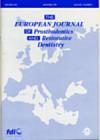European Journal of Prosthodontics and Restorative Dentistry

- Cover Date:
- December 2006
- Print ISSN:
- 0965-7452
- Vol:
- 14
- Issue:
- 4
Book Reviews
Book Reviews
Principles of Operative Dentistry. A J E Qualtrough, Julian Satterthwaite, Leean Morrow and Paul Brunton. ISBN – 1405118210. Price £24.99
The authors of this book seek to inform the reader about the theoretical concepts that underpin the delivery of operative dentistry and endodontology in clinical practice. The aim stated in the preface is to deliver the knowledge required by undergraduate dental students, and professions complimentary to dentistry, who are completing these clinical skills elements of their course. This is a commendable aim, to condense all that is needed into less than 200 relatively small pages, but one that is only partially achieved. The book is structured into eight chapters. Basic Information in Chapter 1 introduces ergonomics in dentistry, examination of the dentition, cariology and moisture control. Chapter 2 introduces principles surrounding surgical caries management and placement of direct restorations. The chapter includes alternatives for caries removal, restorative materials selection, and methods of retention for restorations. Chapter 3 introduces the principles behind endodontic treatment through diagnosis, instrumentation and obturation. Chapter 4 follows with a number of related aspects of endodontics, speciï¬cally: traumatic; periodontal; elective treatment; and subsequent restoration. Chapters 5 and 6 introduce indirect restorations. The structure follows the expected clinical pathway through the indications, restoration prior to preparation, preparation design, restoration design and ï¬nally cementation. Consideration to impression technique and temporisation is given, along with the role of the occlusion. Chapter 7 introduces the ever forgotten requirement of maintaining a restored dentition. Finally, Chapter 8 highlights the need for evidence based practice and routes to reviewing the literature. The information within this text delivers a good basic structure for the professional (training or practicing) to set about the process of understanding the principles surrounding operative dentistry and endodontics. It is of a manageable size to read in half a day and will revisit themes for the practitioner to think about and provide directions of study for the student. There is some good referencing to the supporting literature therefore allowing a quick route to further reading, but as ever this is not extensive. There are a number of good illustrations but the use of black and white photography is somewhat unavoidably bland. The advantage of this text is that it summarises heavily, but this is also where I have my main difï¬culty in recommending it as a text to an undergraduate population. If it is not carefully supplemented, with signiï¬cantly further reading, it is unlikely that the understanding of the basic principles of operative dentistry and endodontics will be developed. The current mind set of the majority of undergraduates is tactical; they will seek to predict the minimum requirement of knowledge required each stage of the course and potentially miss very important concepts along the way. Interestingly, the book closes with a chapter about developing skills for lifelong learning, unfortunately, if it is promoted as a core text, it delivers a potential of this is all that you need.
Dr G I McCracken School of Dental Sciences Newcastle University
TMDs. An Evidence-Based Approach to Diagnosis and Treatment. Edited by Daniel Laskin, Charles Greene and William Hylander. ISBN 0867154470. Hardback, 560 pages, 435 illustrations (110 in colour). Published by Quintessence 2006, ISBN 086715-447-0. Price £93
Most systematic reviews of treatment modalities for Temporomandibular Disorders (TMDs) have tended to conclude that there is not enough good quality evidence to base our treatment of these conditions on. I was therefore intrigued as to how this book would approach what would appear to be a difï¬cult subject; the answer in brief is, very well. This book draws from multiple eminent contributors from the TMDs research ï¬eld each chapter being headed by a relevant expert in the ï¬eld. There are thirty-six chapters in total, divided into six sections. Two of these sections make up the Biologic Basis of TMDs and the remaining four constitute the Clinical Management of TMDs, this being the larger part of the book. All sections of the book are beautifully illustrated, with a quarter of the illustrations being in colour. Despite the multiple contributors the book retains a similar style throughout and therefore is easy to read.
- Article Price
- £15.00
- Institution Article Price
- £
- Page Start
- 190
- Page End
- 191
- Authors
Articles from this issue
- Title
- Pg. Start
- Pg. End
- Comparison of Interocclusal Contacts Registered Intraorally and After a Remount Procedure in Complete Denture Patients.
- 146
- 150
- The Effect of Preparation Height And Taper on Cement Lute Stress: A Three-dimensional Finite Element Analysis
- 151
- 157
- Partial- or Full-Mouth Examination Assessing the Dental and Prosthetic Status among Elderly Individuals
- 158
- 162
- An in-vitro Investigation of the Effect of a Water Additive and a New Acidic Primer on the Tensile Bond Strength of Composite Resin to Human Enamel and Dentine.
- 163
- 168
- A Radiographic Review of Bone Levels Around Calcitek Dental Implants Supporting Mandibular Overdentures. Preliminary Results at 3 to 6 Years.
- 169
- 173
- Effectiveness of a Self-Adhesive Resin Luting System on Fracture Resistance of Teeth Restored with Dentin-Bonded Crowns
- 185
- 188
